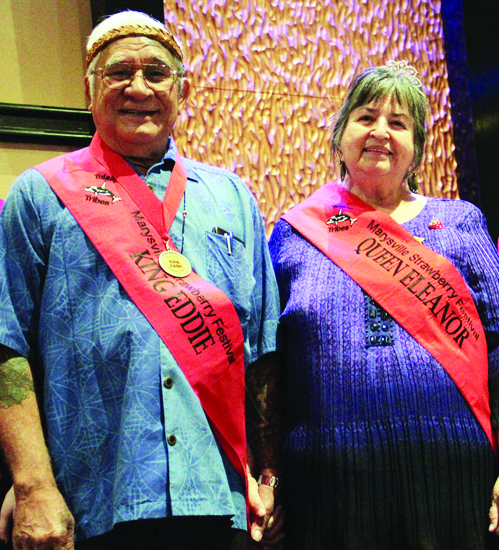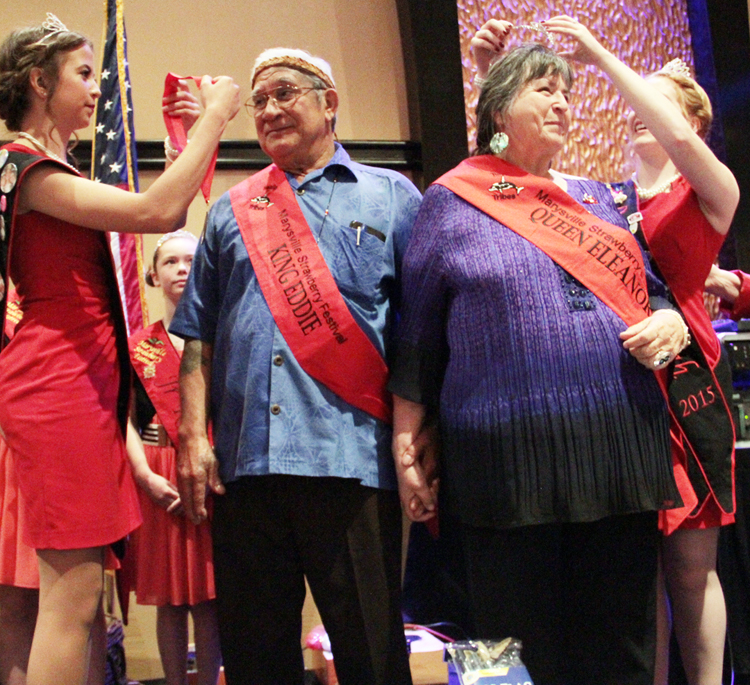
Photo/Mara Hill
by Mara Hill, Tulalip News
Guests travel from all over to participate in the fun and excitement of the annual Elders Luncheon held at Tulalip. For over eighteen years, the Tulalip Tribes has been hosting these luncheons specifically put together to honor elders and seniors. This year it was hosted on May 28 at the Tulalip Tribes Resort and Casino in the Orca Ballroom. Tribal and non-tribal members from our community and surrounding communities come together, find old friends, visit with family and meet new people.
Not only was this Elders Luncheon a day to honor our elders and seniors, it was also a day to crown the King and Queen for our upcoming Strawberry Festival and parade. Each year at least one Tulalip tribal elder is chosen to represent the Tulalip Tribes and the senior community. This year Eleanor Nielsen, a Tulalip tribal member, and her husband Eddie were crowned by the Marysville Strawberry Festival Senior and Junior Royalty.
Eleanor said that she is “proud to be a member of the Tulalip Tribes and to be chosen Queen, representing Tulalip and the Marysville Strawberry Festival.”
Eleanor and Eddie have attended the elders luncheons many times. “It is good to be with family and friends from many tribes. We like sharing the day with everyone,” said Eleanor.
“I am happy to be in the parade and thankful to Tulalip Tribes”, said Eddie.

Photo/Mara Hill
The luncheon included a raffle, which totaled $1500 in cash prize giveaways. There were ten $100 winners and ten $50 dollar winners along with several others who received gift baskets that were donated by tribal departments. In addition to the raffles, students from Tulalip Heritage High School honored the elders and seniors by gifting a blanket to the eldest member at each table.
Tina Brown, Athletic Coordinator at Heritage said “I have been bringing students the past five years to help honor our elders from all over the different reservations and tribes.”
Local and non-local vendors were on hand selling Native crafts and food. Some of the artwork included authentic handmade cedar weaved baskets made by Tulalip Tribal veteran, David Fryberg Sr. Fryberg has been cedar weaving for about 10-15 years and has been vending for approximately 20 years.
Vendors Percy and Ida Kanesta, a couple from Tacoma, have been selling their authentic handmade Native Zuni jewelry at the elder luncheons for almost 15 years and have been hand-making family oriented jewelry for nearly 50 years. Some of the jewelry they make is created out of turquoise, black onyx, silver, lapis, and malachite.
Jimi Pablo a Tulalip tribal member is a first-time vendor at the luncheon but has been in the vending business over 34 years. Pablo was selling fresh, handmade yeast bread. He explained that he had started making the bread at 4:30 p.m. the day before the luncheon and didn’t finish until 4:30 a.m. that day.
Wrapping up the 50’s inspired event were rounds of singing and possibly even a poodle skirt twirl or two.
Contact Mara Hill, mward@tulaliptribes-nsn.gov





